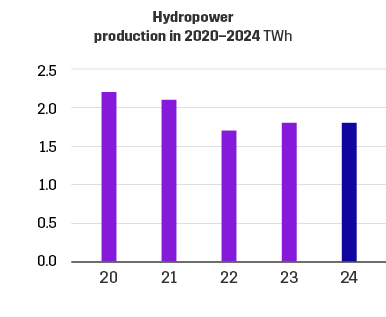Renewable hydropower is linked to climate targets
Hydropower is a renewable, domestic, distributed, carbon-neutral and highly flexible form of electricity production.
Hydropower is Finland’s most important source of renewable energy. A third of all Finland’s renewable electricity is produced with hydropower. Hydropower accounts for approximately 20 per cent of Finnish electricity production.
The total capacity of Finland’s hydropower is 3,100 MW. Hydropower plants along Finland’s six biggest rivers provide 96 per cent of the hydropower capacity.
We are one of Finland’s biggest hydropower producers
Pohjolan Voima’s hydropower company PVO-Vesivoima Oy produces electricity at its hydropower plants on the Iijoki, Kemijoki, Kokemäenjoki and Tengeliönjoki rivers. There are twelve power plants, four of which are partially owned.
We produce approximately 1.8 TWh of electricity using hydropower each year. Our power plants have been built or expanded between 1949 and 1997, as well as in 2016. The capacity of the power plants is 543 MW, of which our share is 451 MW. Our hydropower plants are controlled from UPM Energy’s control facilities in Tampere.
Read more about our hydropower plants

More regulating capacity and energy efficiency with modernisations
Continuous maintenance keeps our hydropower plants in great condition. With well-planned modernisations, we can further expand the lifecycle of our power plants, improve energy efficiency and enhance our power plants’ capability of supporting the operations of the electricity system by producing regulaiting power.
Our modernised hydropower plants are modern, reliable and energy-efficient power plants.
Modern technology expands the long life cycle of our power plants
Modern technology has also brought environmental benefits and minimised environmental risks.
We have invested extensively in the renovation and modernisation of our power plants in recent years, and the work continues:
- In Tengeliönjoki river, the Portimokoski hydropower plant will undergo a major overhaul in the second half of 2026
- In Kokemäenjoki river, the refurbishment of the turbines at the Melo hydropower plant began in late 2024 and are scheduled to be completed by the end of 2025
- In Iijoki river, the overhaul of the turbine at Haapakoski hydropower plant was completed in January 2025
- In Iijoki river, the Raasakka hydropower plant’s second generating unit was modernised by replacing the original stator by a new one in 2023
- In Kemijoki river, the Jumisko power plant was renovated in 2021
- In Iijoki river, the Raasakka power plant’s electrical and automation systems were renewed in 2018
- In Kemijoki, the Isohaara power plant’s electrical automation was renewed in 2016–2017
- In Kokemäenjoki, the Harjavalta power plant was renovated in 2015–2017 and a new machinery was built in 2016
- In Kokemäenjoki, the Melo power plant was renovated in 2014–2015
- In Iijoki, four power plants were renovated in 2005–2013, increasing their total power by 20 MW
We develop production in co-operation
We also seek new solutions in co-operation with our network to develop the regulating capabilities, operation and maintenance of our power plants. With co-operation we can also further enhance the co-existence of hydropower production and the development of aquatic environment.
Finland’s most advanced automation solution for river regulation has been introduced at all the Iijoki hydropower plants. It controls the production at the Iijoki plants as a whole and boosts the efficiency of balancing power production, thus contributing to the green transition. The aquatic environment will benefit from the more accurate water level control.
In collaboration with the University of Oulu we have studied the regulating capabilities of our hydropower plants and developed a totally new type of turbine governor. The innovation enables much faster and more accurate control of the electricity production as well as as protects the equipment.
Active cooperation for the aquatic environment
We work in extensive co-operation to develop the aquatic environment. We actively cooperate with various stakeholders for the benefit of migratory fish and the aquatic environment (municipalities in the area, the Council of Oulu Region, the Centres for Economic Development, Transport and the Environment, the Ministry of Agriculture and Forestry, Natural Resources Institute Finland, local residents, fishery associations and collectives, as well as Metsähallitus).
We are committed to collaboration, based on research and proceeding stage by stage, to promote the restoration of the natural migration patterns of migratory fish.
Read more about this in the responsibility pages.